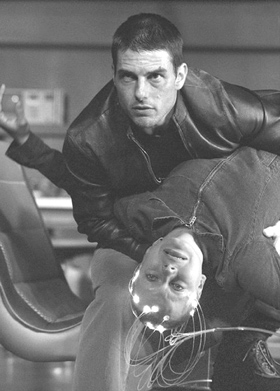The tag line for Cruise’s newest film, Minority Report (directed by Steven Spielberg and released last Friday to national audiences) reads: “Everybody runs.” While it may not be exactly true that everybody runs in this film, Mr. Cruise certainly does. Finally finding a role which allows him to let loose at what he is best at, Cruise shines with exuberance and visceral charisma as he runs and runs and runs nearly nonstop for close to two and a half hours. That’s an impressive amount of running, kind of a cinematic marathon if you think about it. What is most impressive, however, is that what Cruise runs through is so rich and exciting.
Minority Report, based on a story by science fiction author cum cult icon Philip K. Dick, spins a variation on the time-honored formula of the innocent man unjustly accused. The premise here is intriguing, and somewhat disturbing: in the future, crimes will be prevented before they happen. Thanks to efforts of three ambiguously human psychics, called-suitably enough-the “Pre-Cogs” (short for “precognition”), the Department of Pre-Crime has effectively eradicated crime in the United States. The film merely glances over the ethical and philosophical questions raised by this method of crime prevention, making only a few forgivable forays into abstraction, and focuses instead on the action that ensues when such a system becomes corrupted.
In retrospect, this is a wise decision: Spielberg is no Ingmar Bergman, and his recent attempts to market himself as a thinking man for the masses have been fairly trite; either action films without action, or art films without art. And, let’s face it; Cruise can sound downright silly when his dialogue gets too intellectual. The two have their strengths though; Spielberg is a master of eye-catching visuals and of film rhythm, and Cruise has attitude. The film builds on these strengths and uses them to maximum effect.
Apart from running, Cruise does do some talking, and makes some valiant, if vain, attempts at emoting. Cruise is not a great actor by any standards (his surprisingly adept turn in the film Magnolia being the notable exception), yet he is an alluring personality and capable of involving the audience.
There are a few weak points in Minority Report: I would suggest not paying too much attention to the dialogue, most of which is simply, and often too obviously, plot explication. That which attempts to be emotional or philosophical is, in both cases, mainly just silly. Calling the chamber where the Pre-Cogs live the “Temple” is excusable, but when the agents of Pre-Crime start comparing themselves to priests, one might feel it hard to suppress a groan as the Hammer of Obvious Symbolism whacks the back of one’s head.
Still, such complaints are irrelevant; Minority Report is not meant to be a brain-fest. Its appeal is to the simpler senses. The action scenes are creatively staged, adrenaline-inducing, and often spiked with touches of sly humor.
Thought the dialogue may be weak, the story itself is pretty strong. A stock idea, an accused man out to vindicate himself, is revitalized by quirky flourishes and original presentation. Two scenes in particular stand out: Cruise’s visit to a demented surgeon shivers with a creepiness worthy of David Lynch, and a later visit to a futuristic pleasure palace is both funny and frightening, a perfect balance of what is best about this film.
Moreover, the vision of the future presented in the film is truly astounding. The labyrinthine city through which Cruise is chased is like Metropolis on steroids; everything is motion and expressionist eye-candy. It is a world in which operating a computer becomes an act of balletic agility, cars drive up walls, and even the plants move. The scene in which the “imprisoned” bodies of convicts rise from the ground like an army of Lazuruses has to be seen to be believed.
Influences abound in the film; Fritz Lang and Terry Gilliam are two obvious ones. Perhaps the clearest influence, however, is that of Stanley Kubrick, with whom Spielberg worked intensively during the last years of the late master’s life, and from whom he seems to have learned some valuable lessons about composition and atmosphere.
Perhaps Steven Spielberg, for all his tendencies to maudlin moralizing, is really an existentialist: what his characters say is never as important or as intriguing as what they do, and his ideas are best expressed when shown through concrete images rather than conversation. Abandoning the sermonizing that has marred his recent work, the parablistic A.I. for example, Spielberg here uses his talent for stunning visuals and his grasp of pacing action, of combining humor and danger to build tension, to make a statement about the condition of man in the modern world that is truly involving.
The look he uses-the film seems to have had all its color sucked out digitally and then re-injected in a highly stylistic manner-is both beautiful to look at and dramatically expressive of Spielberg’s vision of a bleak, dream-like future. Overall, the style Spielberg exhibits in Minority Report indicates a fresh, new direction for the filmmaker, one that he will hopefully continue to develop.
While he may not be the artist that he wants to be, he is a superlative magician and he is strongest as a director when he lets his images speak for themselves. Minority Report exemplifies the qualities of Spielberg’s best work; it creates a sense of wonder and awe at the fantastical possibilities of filmmaking, and it inspires the imagination.
In Tom Cruise, Spielberg may have found his perfect hero: both Cruise and Spielberg are most convincing when they focus on action. When not weighed down by cumbersome intellectualism, they are free to do what they do best: dazzle the audience with charisma and imagination. Minority Report is a dazzler.





















































